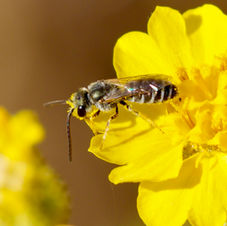Bee Identification Guide
Bee Basics
Bee Anatomy
Bees are insects, and therefore have segmented bodies, jointed legs, and external skeletons (i.e. an exoskeleton). A bee body consists of three sections: head, thorax and abdomen. Bees have two pairs of wings and long, segmented antennae - both characteristics help distinguish them from flies that often mimic them.

Bee Scopae
Female bees usually use scopae to transport pollen and nectar to their nests. Scopae are composed of specialized hairs and, in most bees, are located on the hind legs of the bee. However, bees in Family Megachilidae (see lower photo), have scopae on the underside of their abdomen.

Bee Wings
As an example, this is the forewing of an Anthophora bee, showing a small stigma, and the 3rd submarginal cell (the submarginal cell furthest outside) is relatively parallel-sided.

Bee Sizes
Large Bee: > 15 mm
Medium Bee: 8-15 mm
Small Bee: 3-7 mm

What's Buzzing on Mount Diablo
Native bees of Mount Diablo do not include the European Honey Bee (Apis mellifera), an import to North America (but not directly to California) from Europe in 1622. The European Honey Bee is actually a complex of hybrids involving various subspecies. Unlike Apis mellifera, native bees do not make honey. Because they are mostly short-lived and generally not highly social, native bees do not need to produce honey to sustain an ongoing hive through the winter and beyond. Bees are said to have a complete, or holometabolous, life cycle that includes four stages: egg, larva, pupa and adult. The larval stage is grub-like, differing greatly from the adult bee. The pupal stage is a non-feeding stage through which the larva transitions to an adult bee. Bees can select sexes of their young: Males develop from unfertilized eggs. Bees typically lay female eggs first (in lower cells in a burrow) and necessarily provide more ample food supplies for daughters than for sons. The great majority of native bees are solitary bees: non-social female bees that build and maintain their own nests, and are capable of laying their own eggs. Some do build communal nests, where female bees share a nest entrance, but where each female behaves as a solitary bee. Less than 10% of bees worldwide are social bees: possessing reproductive division of labor, cooperative care of young and overlap of generations. Food provisioning for young usually consists of a combined nectar/pollen mass, sometimes liquid, that partially fills the nest cell. An egg is laid in the cell with the food contents (sometimes on the cell walls and sometimes on the food provisions). After the larva finishes feeding on provisioned food, it goes through the pupation process, and later emerges as an adult. Clues to the identity of the bee you are observing can sometimes be discerned in what the bee is doing. For example, if you see a bee that appears to be nesting in wood, you can narrow likely identification possibilities to carpenter bee (genus Xylocopa), small carpenter bee (genus Ceratina), one of the bees in genus Megachile in Family Megachilidae (a leafcutter bee) or mason bee that could be in genus Osmia, Hoplitis, or Ashmeadiella. Furthermore, size and color of the bee can help greatly in bee identification, as can head and body shape. The Descriptions in this guide should help you. Nectar serves primarily as a source of energy for flight and other activities, while pollen serves as nutrients for reproduction (ovarian and brood development). Bee species often appear in timing with their favored flowering plants. Native bees serve as keystone species, as they are, in part, responsible for shaping the rise of flowering plants in world ecosystems through pollination. This is important when we consider their importance to agricultural crops. Native bees also serve as an important food source for animals up the food chain.
"Bee" an expert and buzz over to our online store to order a copy of Native Bees of Mount Diablo by Daniel Sandri.
Visit the MDIA Store








